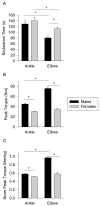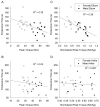Sex differences in fatigue resistance are muscle group dependent
- PMID: 20195184
- PMCID: PMC2917609
- DOI: 10.1249/MSS.0b013e3181d8f8fa
Sex differences in fatigue resistance are muscle group dependent
Abstract
Purpose: Women are often reported to be generally more resistant to fatigue than men for relative-intensity tasks. This has been observed repeatedly for elbow flexors, whereas at the ankle, sex differences appear less robust, suggesting localized rather than systemic influences. Thus, the purpose of this study was to examine sex differences in fatigue resistance at muscle groups in a single cohort and which factors, if any, predict endurance time.
Methods: Thirty-two young adults (age = 19-44 yr, 16 women) performed sustained isometric contractions at 50% maximum voluntary isometric contraction to failure for elbow flexion and ankle dorsiflexion. Pain, exertion, and muscle EMG were assessed throughout. Self-reported baseline activity was measured using the International Physical Activity Questionnaire.
Results: Women were significantly more resistant to fatigue than men at the elbow (112.3 ± 6.2 vs 80.3 ± 5.8 s, P = 0.001) but not at the ankle (140.6 ± 10.7 vs 129.2 ± 10.5 s, P = 0.45). Peak torque was greater in men than that in women (P < 0.0001) at the ankle (45.0 ± 1.7 vs 30.1 ± 1.0 N·m) and at the elbow (75.7 ± 3.1 vs 34.4 ± 2.2 N·m). Peak torque was significantly related to endurance time at the elbow (R2= 0.30) but not at the ankle (R2 = 0.03). Peak pain, rate of pain increase, peak exertion, EMG, and baseline physical activity did not differ between sexes.
Conclusions: Sex differences in fatigue resistance are muscle group specific. Women were more fatigue resistant at the elbow but not at the ankle during a sustained isometric contraction. Further, factors that may contribute to fatigue resistance for one muscle group (e.g., sex, peak torque) may not be critical at another.
Figures




Similar articles
-
Muscle fatigue in response to low-load blood flow-restricted elbow-flexion exercise: are there any sex differences?Eur J Appl Physiol. 2018 Oct;118(10):2089-2096. doi: 10.1007/s00421-018-3940-x. Epub 2018 Jul 13. Eur J Appl Physiol. 2018. PMID: 30006670
-
Supraspinal fatigue does not explain the sex difference in muscle fatigue of maximal contractions.J Appl Physiol (1985). 2006 Oct;101(4):1036-44. doi: 10.1152/japplphysiol.00103.2006. Epub 2006 May 25. J Appl Physiol (1985). 2006. PMID: 16728525
-
Influence of aging on sex differences in muscle fatigability.J Appl Physiol (1985). 2004 Nov;97(5):1723-32. doi: 10.1152/japplphysiol.00460.2004. Epub 2004 Jun 18. J Appl Physiol (1985). 2004. PMID: 15208285
-
Sex differences in fatigability of dynamic contractions.Exp Physiol. 2016 Feb;101(2):250-5. doi: 10.1113/EP085370. Epub 2015 Nov 17. Exp Physiol. 2016. PMID: 26440505 Free PMC article. Review.
-
Age-related differences in muscle fatigue vary by contraction type: a meta-analysis.Phys Ther. 2011 Aug;91(8):1153-65. doi: 10.2522/ptj.20100333. Epub 2011 May 26. Phys Ther. 2011. PMID: 21616932 Free PMC article.
Cited by
-
Biomechanical constraints on the feedforward regulation of endpoint stiffness.J Neurophysiol. 2012 Oct;108(8):2083-91. doi: 10.1152/jn.00330.2012. Epub 2012 Jul 25. J Neurophysiol. 2012. PMID: 22832565 Free PMC article.
-
Adapting a fatigue model for shoulder flexion fatigue: Enhancing recovery rate during intermittent rest intervals.J Biomech. 2020 Jun 9;106:109762. doi: 10.1016/j.jbiomech.2020.109762. Epub 2020 Apr 28. J Biomech. 2020. PMID: 32517992 Free PMC article.
-
A four-compartment controller model of muscle fatigue for static and dynamic tasks.Front Physiol. 2025 Feb 12;16:1518847. doi: 10.3389/fphys.2025.1518847. eCollection 2025. Front Physiol. 2025. PMID: 40013240 Free PMC article.
-
No sex differences in evoked contractile properties after fatiguing isometric and isotonic exercise for the plantar flexors.J Musculoskelet Neuronal Interact. 2022 Dec 1;22(4):504-513. J Musculoskelet Neuronal Interact. 2022. PMID: 36458388 Free PMC article.
-
Revealing Sex Differences During Upper and Lower Extremity Neuromuscular Fatigue in Older Adults Through a Neuroergonomics Approach.Front Neuroergon. 2021 Aug 16;2:663368. doi: 10.3389/fnrgo.2021.663368. eCollection 2021. Front Neuroergon. 2021. PMID: 38235250 Free PMC article.
References
-
- Borg G. Borg’s Perceived Exertion and Pain Scales. Human Kinetics; Champaign, IL: 1998. pp. 63–7.
-
- Calder KM, Stashuk DW, McLean L. Physiological characteristics of motor units in the brachioradialis muscle across fatiguing low-level isometric contractions. J Electromyogr Kinesiol. 2008;18(1):2–15. - PubMed
-
- Craig CL, Marshall AL, Sjostrom M, et al. International physical activity questionnaire: 12-country reliability and validity. Med Sci Sports Exerc. 2003;35(8):1381–95. - PubMed
-
- Dimitrova NA, Arabadzhiev TI, Hogrel JY, Dimitrov GV. Fatigue analysis of interference EMG signals obtained from biceps brachii during isometric voluntary contraction at various force levels. J Electromyogr Kinesiol. 2009;19(2):252–8. - PubMed
-
- Dotan R, Falk B. Task-specific sex differences in muscle fatigue: is there a common underlying cause? Exerc Sport Sci Rev. 2010;38(1):36. - PubMed
Publication types
MeSH terms
Grants and funding
LinkOut - more resources
Full Text Sources

